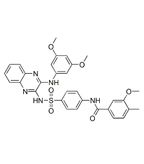AACR: Anti-PI3K/MEK Inhibitor Targeted Therapy Combo Shows Activity
A new agent, SAR245409, that simultaneous targets two pathways important for the growth of tumors--the PI3K/mTOR pathway and the MAPK pathway--has shown activity in advanced solid tumors, according to results from a phase I trial presented at the American Association for Cancer Research Annual Meeting.
Washington, DC-The simultaneous targeting of two pathways important for the growth of tumors, the phosphatidylinositol 3-kinase (PI3K)/mammalian target of rapamycin (mTOR) pathway and the mitogen-activated protein kinase (MAPK) pathway, has shown activity in advanced solid tumors. The results from the phase I trial were presented by Jeffrey Infante, MD, medical oncologist and director of drug development at the Sarah Cannon Research Institute in Nashville, Tennessee, at the American Association for Cancer Research (AACR) Annual Meeting, held April 6–10 in Washington, DC.

Chemical structure of SAR245409
The dose-escalation trial tested the combination of the dual PI3K/mTOR inhibitor SAR245409 with the MEK1/2 inhibitor pimasertib in 46 patients with cancers that frequently have mutations in these pathways. Both therapies were given once daily and in various dose combinations. The most common tumor types in the trial were colorectal (16), pancreatic (7), and non–small-cell lung (7).
Two partial responses were observed, in a patient with KRAS-mutated colorectal cancer whose tumor had neuroendocrine features had an 80% tumor reduction, and in a low-grade ovarian cancer patient with KRAS- and PI3KCA-mutated tumors. A third patient with low-grade ovarian cancer with no mutation in PI3KCA or KRAS had 29% tumor shrinkage. Seven patients had stable disease for longer than 12 weeks. Patients with stable disease included those with colorectal cancer, non–small-cell lung cancer, melanoma, and bladder cancer.
A mutation in either RAS or PI3K was not a prerequisite for enrollment in the trial, but the mutational status of patients was assessed by sequencing, as well as the BEAMing circulating tumor DNA technique.
Frequent adverse events included diarrhea (54% of patients), fatigue (50%), nausea (41%), vomiting (39%), and dermatitis acneiform (39%). Grade 3 and 4 toxicities were infrequent-the most common grade 3 event was skin rash in 14% of patients. Other grade 3/4 toxicities occurred in less than 4% of all patients.
Eye-related adverse events, including visual disturbances and serous retinal detachment, occurred in 28% of patients. While concerning, “the vision-related adverse events seem to be manageable,” said Infante during his presentation. “But it is a learning curve in the clinic,” he added.
The maximum tolerated dose was the combination of 90 mg of pimasertib daily and 70 mg of SAR245409. The recommended tolerated dose for phase II testing is 60 mg of pimasertib and 70 mg of SAR245409, each given once daily.
“This combination has activity but has not looked like a home run [based on the results so far],” said Jeffrey Engelman, MD, PhD, professor of medicine at Harvard Medical School, during his discussion of the results. Engelman attributed a lack of robust activity of two agents that target the MAPK and the PI3K pathways to the difficulty of suppressing both pathways all the time in a single patient.
The phase I trial is currently ongoing with four expansion cohorts in colorectal cancer, triple-negative breast cancer, non–small-cell lung cancer, and melanoma, each enrolling 18 patients at the recommended tolerated dose.
Both the PI3K/mTOR and the MAPK signaling pathways are frequently found mutated in various different tumor types. Researchers have uncovered pivotal roles for these pathways in both cancer development and sustaining tumor growth.
For example, it is estimated that more than 30% of invasive breast cancers have an aberration in the PI3K pathway. These mutations include activating mutations in PIK3CA, the gene that encodes the catalytic subunit of PI3K; mutations in the gene that encodes AKT1; amplification of AKT2; and mutations in the PTEN gene. Inactivation of the PTEN tumor suppressor gene is the most common genetic alteration of the PI3K pathway.
The various isoforms of AKT are downstream targets of PI3K, and PTEN normally inhibits PI3K activity.
MEK is part of the MAPK pathway that is one of the pathways that controls cellular growth. Mutations in the RAF genes are frequently found in cancers. In melanoma, approximately 40% to 50% of patients with cutaneous melanomas have tumors with a mutation in BRAF that leads to constant activation of downstream signaling through the MAPK pathway, including the MEK protein.
The rationale for the combination of pimasertib and SAR245409 was preclinical data showing better antitumor efficacy of the combination in human tumor–derived cell lines and xenograft mouse models with activating KRAS and PI3K pathway mutations compared with monotherapy treatment.
Pimasertib is also in phase II for NRAS-mutated cutaneous melanoma as a monotherapy, as well as for pancreatic cancer in combination with gemcitabine. Pimasertib is being developed by Germany-based Merck KGaA.
SAR245409 is being studied in phase II trials for chronic leukocytic leukemia and non-Hodgkin lymphoma. A phase I/II trial combining SAR245409 with letrozole for hormone-positive breast cancer is also ongoing. SAR245409 is developed by the France-based Sanofi.